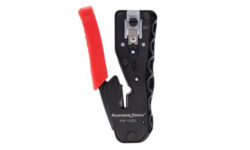How the ‘Best Place to Live in Illinois’ Chose and Installed Its Video Security Solution
A well-known Chicago suburb, the Village of Schaumburg has a five-year plan to add video security to more than 30 locations.

Pictured above (l-r): Peter Schaak, Director of IT, Village of Schaumburg; Pentegra Systems’ President Greg Augspurger, CEO Ed Karl, Security Engineering Manager Gene Brierton and Sales Manager Jim Lichter; Chris Westgor, Technical Services Manager, Village of Schaumburg. (Photo Courtesy Gene Brierton)
Cities, towns and other municipalities are continuing to discover the enhanced safety and value afforded to them through the use of today’s video security systems. The great news is video platforms and system components have advanced in capabilities to bring more scalability, flexibility, compatibility, usability and affordability.
This is allowing manufacturers, consultants, integrators and end users to make rock-solid investment cases that are helping loosen funding constraints and bring to fruition the power of fully realized collaborative security solutions. A prime example of this all coming together can be found just outside Chicago.
The Village of Schaumburg is a well-known northwestern suburb of Chicago and recognized by many in the security industry as the former home of Motorola.
With a population of just less than 75,000 residents, Schaumburg was recently ranked as the best place to live in Illinois (2018) and the ninth best place to live in the United States (2017) by Money.
In talking to both residents and village employees, the reason behind these high scores becomes apparent; there is an unrelenting focus on cost effectively delivering value to residents in terms of safety, services and community resources.
In 2016 the village began to implement a plan for adding video cameras to various properties as a proactive measure, with a goal of creating an enterprise platform for video security.
“This was not driven by a specific incident or group of events,” explains Peter Schaak, the director of IT for the village who led the project. “We felt there was a need to capture certain activity at critical areas, without being intrusive to residents and employees.” The system was to look outward, not inward, and was divided into five logical steps, or phases, with a multiyear implementation envisioned.
The initial approach was to design the system internally, as with other IT projects, but the benefits of working with an outside consultant became apparent as the team got further into the project. “We wanted someone to look over our shoulder and catch common oversights based on their experience,” Schaak says.
A higher level of detail based on similar experience would minimize ambiguities in the technical specification, reducing costs as there wouldn’t need to be as great a buffer for unknown contingencies.
A more comprehensive and well documented design would also make the project more enticing to a higher tier of integrator and give the village a sense of security, in that there would be someone on the team who had done this before. “And it was nice not to have to do this all on our own,” adds Schaak.
Following is an inside account of how the consultant, integrator and end user have smoothly coordinated the project thus far.
Designing the System
The village took the work it had done to date on a system design and incorporated it into a Request for Qualifications (RFQ) for consulting services. Thirteen responses were received, with R. Grossman and Associates (RG&A) ultimately selected to design, bid and project manage the years-long enterprise.
Having clearly defined requirements from the client was tremendously helpful and using its RFQ as a starting point for the system design, an extensive information gathering effort was undertaken to create a design that, when complete, will connect and centrally monitor in excess of 200 cameras in 30 locations throughout the village.
These include the Village Hall, performing arts center, public safety building, senior center, municipal airport, commuter rail station, engineering and public works building, five fire stations and 12 water infrastructure facilities (towers and tanks).
The system was designed with a distributed architecture to minimize the bandwidth requirements while maintaining image quality (frame rate, resolution and compression). For the most part, cameras would be recorded on a server at each location, with the exception of a few spots that were already connected via fiber and had dark fiber strands available.

The video security system will span 30 locations throughout the village. These include the Village Hall, performing arts center, public safety building, nursing division, senior center, municipal airport, commuter rail station, engineering and public works building, five fire stations and 12 water infrastructure facilities.
Servers installed in conditioned space (or open interior space where temperature was not an issue) utilized 1RU Razberi servers with four data drives that can be put into a RAID-5 configuration, and a solid-state drive (SSD) for the operating system and VMS software.
Locations that did not have any sort of temperature control (such as water towers) utilized hardened servers rated for an operating environment ranging from -13°F to 140°F with 10% to 90% noncondensing relative humidity, to be on the safe side.
All servers were integrated boxes, incorporating integrated PoE+ network switches for the associated cameras, and were sized for the implementation of all phases.
For example, if there were two adjacent buildings that were covered in different phases, the server was sized to handle the total camera count, reducing costs in later phases. Reliability was important as well; all patchable cabling utilized pass-through keystone jacks rather than 110-style punch-down blocks to simplify troubleshooting later.
SSDs were used exclusively on the hardened servers for both the operating system and VMS software, and a separate SSD was used for data. Surge protection and UPS systems were implemented throughout.
Selecting the Integrator
The RFP was released October 2016 and was designed to be scalable. There was a base bid that included certain elements common to all phases of the project (i.e. operator workstations) and four additional phases that could, for the most part, be implemented in any order — all required the base bid, but only Phase 5 had other dependencies.
The 11 responses were generally excellent and included a good cross section of national, regional and local integrators. Pricing was varied — the high bidder was almost three times as much as the low bidder — but fell into roughly three pricing bands, once bidders that lacked credibility were disqualified.
Choice of a VMS impacted pricing, so some time was spent on that to narrow the field (see Deploying a Modular System Design on page three).
PHOTO GALLERY: Click here for more images from the project.
After careful consideration, Addison, Ill.-based Pentegra Systems was selected as the integrator believed to best serve the village and this project. Founded in 2000, Pentegra has won several awards and was extremely responsive throughout the evaluation process.
Its team, including CEO Ed Karl, President Greg Augspurger, Security Engineering Manager Gene Brierton and Sales Engineer Jim Lichter, impressed with their knowledge, experience and collaborative approach, and their references echoed those sentiments.
Their solution included Antaira Technologies hardened network switches, Axis cameras, EnGenius EnStation AC wireless links and Razberi servers (both hardened and rack mounted).
Once the final submittals were received and approved and contracts were in place, work commenced on Phase 1 of the installation, which included six locations and roughly 70 cameras.
Keep reading for details about installing the solution…
If you enjoyed this article and want to receive more valuable industry content like this, click here to sign up for our FREE digital newsletters!

Security Is Our Business, Too
For professionals who recommend, buy and install all types of electronic security equipment, a free subscription to Commercial Integrator + Security Sales & Integration is like having a consultant on call. You’ll find an ideal balance of technology and business coverage, with installation tips and techniques for products and updates on how to add to your bottom line.
A FREE subscription to the top resource for security and integration industry will prove to be invaluable.









